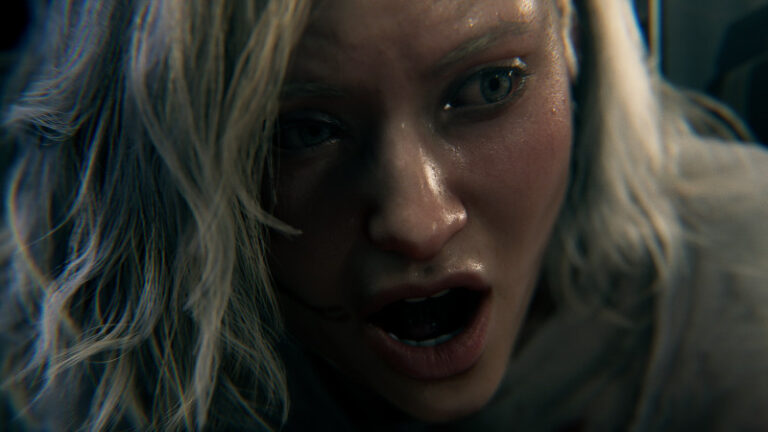
Over the last few years, Capcom’s been rapidly changing most of their biggest franchises. Watching Resident Evil 6 move the franchise to rapid, fast paced action, Ace Attorney going fully 3D and DmC: Devil May Cry being rebooted, Capcom has left fans guessing as to which franchise would receive the next big change. Surprisingly, Lost Planet, a significantly younger franchise than the aforementioned games, has already established itself as an over-the-top action shooter, with the sequel boasting the ability to “Kill Big,” showcasing the ridiculous colossi that you and your friends could take down together in co-op. But the winds of change have caught up with this action shooter franchise, and it may or may not be for the best.
Even as the game boots up, the tone is clearly different from the previous LP games. Previous games had heroic, base-heavy adventure music, reminiscent of Marvel vs. Capcom– clearly signaling the starting bell for an epic action adventure. LP3 begins with a quiet, spooky piece of music, deeply borrowing from James Horner’s theme for Aliens. The menu is dark, and frozen over, with holographic panels displaying the options, reminiscent of Dead Space 3‘s main menu design. I was ready for horror- there was a reason we opted to review this one- but it was still a strange feeling seeing how utterly different it was from the previous games.
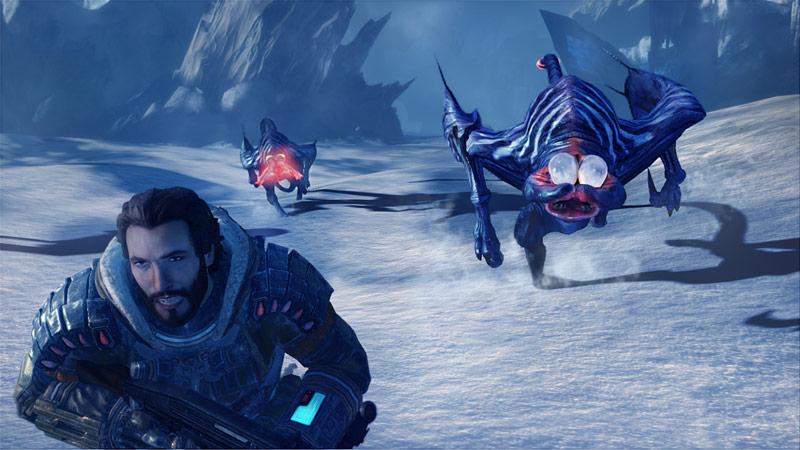
The game begins some couple hundred years before the events of the original game, showcasing the early days of series’ home E.D.N. 3’s colonization, back when it was simply being harvested for the precious energy source, T-Energy. We step into the boots of Jim Peyton, an engineer working for the NEVEC Corporation, sent to fix equipment and mine for T-Energy at the first mining base established on the planet. Jim is surprisingly likable, and shows a three-dimensionality I’m not used to from Capcom’s characters, who tend to have singular motivations and easily pinpointed reactions. Jim feels more organic than that; he’s a tired, middle-aged guy who’s just workin’ a job. His rig (the giant mechanical walker he pilots to get from place to place) is equipped with an MP3 loaded up with country music, and a lived-in interior, which is fitted with post-it notes and a photo of his wife, quickly makes you feel at home. Jim feels like any trucker you could meet at a bar along the side of the highway, blowing smoke through his beard and laughing at dirty jokes with his fellow drivers.
Occasionally, the game will break away from the action for Jim to engage in video mail with his wife, which is heart-warming and charming, and makes Jim feel even more relatable. Hearing him explain aspects of his daily life, seeing how he talks to her and what aspects of his typical day he chooses to spruce up to impress family back home – or quietly watching the videos his wife sends with sparkling eyes, feeling warm in the glow of her smile – only for him to get a little too zoned out and jump as he spills his coffee all over his lap, swearing and trying to clean it up while the video keeps playing. It feels real and familiar.
Your home is your castle, and the research colony on E.D.N.3 feels like it’s not only your home, but also the home of every one else working on the planet. As you explore, you’ll find other NEVEC employees laughing around a few beers, playing songs for each other, complaining about workmen’s comp, and so on. The world of Lost Planet 3 feels realistically lived in and relatable, despite the science-fiction setting. I feel more like I’m onboard Firefly‘s Serenity, with friends and co-workers beginning to feel more like family the more you explore. But once you take on a mission and set out into the icy wastelands of E.D.N.3., everything changes.
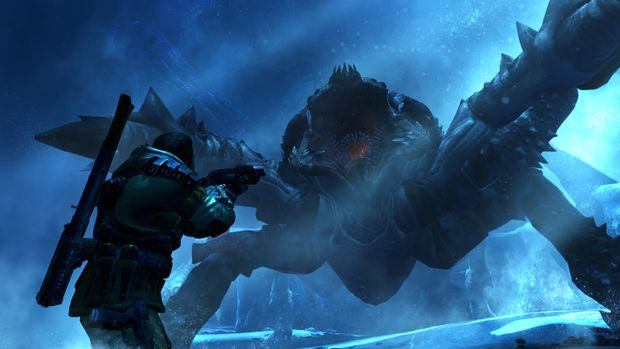
The main threat is the local wildlife, the Akrid, which attack in swarms, similar to Starship Troopers’ alien bugs. Upon exterminating one of them, their blood spills, leaking out T-Energy, which is now used as currency instead of replenishing your own thermal energy like in the original Lost Planet. The camera is off-center over the shoulder, like Resident Evil or Dead Space, and combat boils down to running and gunning through swarms of Akrid bugs. Occasionally, to take down some of the bigger Akrid, Jim will be able to duck into his RIG to fight them one-on-one, Power Rangers style. Disappointingly, this boils down to little more than a series of quick time events, and can feel dull, despite how epic it should feel. The previous game’s grappling claw returns, but is boiled down to a simple grappling hook, only offering the player the ability ascend at specially marked points. I had just finished re-playing Batman: Arkham City, and the grappling hook functions exactly the same, save for also providing the ability to descend.
I then started to really apply some thought to what I was playing, and came to an inevitable conclusion. Lost Planet 3 is a complete pantomime. Not of any one specific thing, but of a multitude of different sources. Everything has inspirations; there isn’t a video game in the world that doesn’t owe some other creative property its thanks, but Lost Planet 3 not just borrows, instead openly taking from other games and films. I’ve already sighted strong similarities to Firefly, Aliens, Batman and Resident Evil, but it goes deeper.
The plot centers on a deep conspiracy revolving around the NEVEC Corporation; evil corporations aren’t new to video games, but the way it’s presented is deeply “inspired” by the movie Alien. The previously lived in and relatable feel of the colony suddenly gave way to hallways ripped straight out of Star Wars: The Empire Strikes Back‘s rebel base on Hoth. The series’ life blood, T-energy, which was originally used as a way to keep the characters alive as the cold froze them to death, is now boiled down to cash-in gameplay and Gears of War‘s Imulsion for the story. There’s even a moment where Jim stumbles into a huge cavern with an enormous lake of lava that mimics a sequence from the original Gears of War where the stars traverse an Imulsion stream.
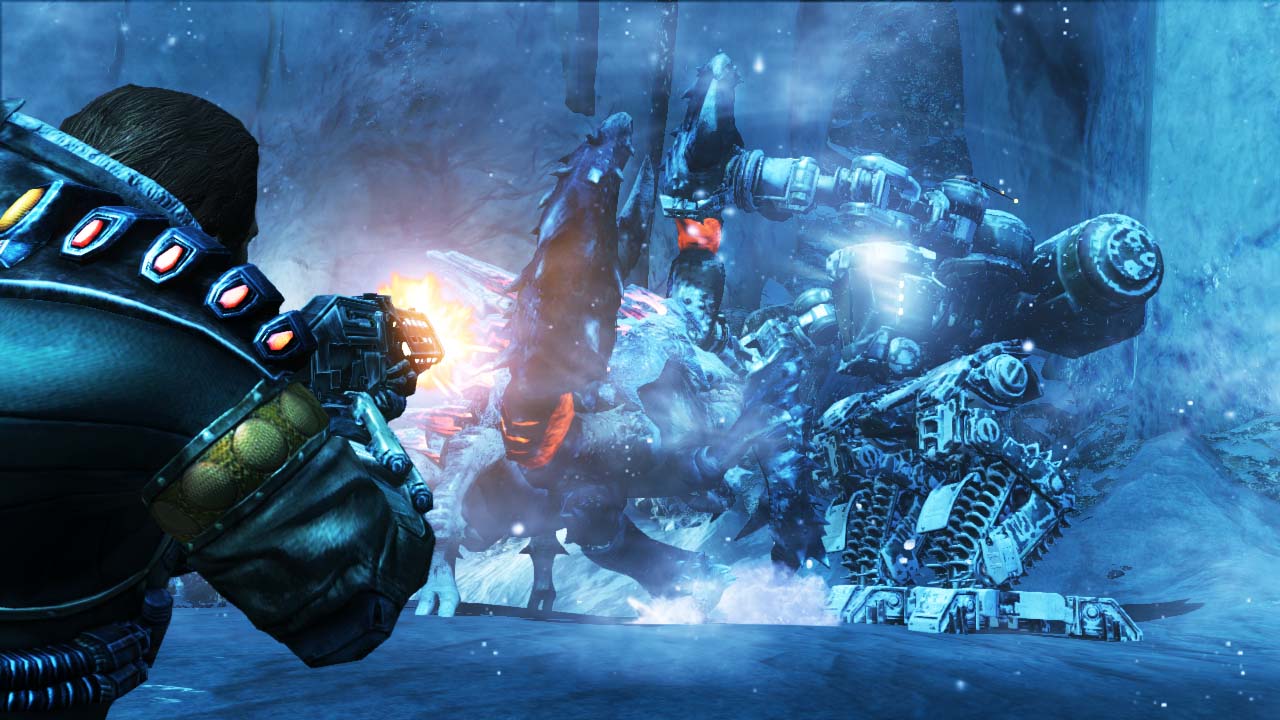
Jim Peyton’s personality feels fresh, but his job and missions are step and repeat from Dead Space‘s Isaac Clarke: an engineer who is constantly being sent to fix equipment to save lives, or his own, occasionally playing through mini-games to fix things – which play exactly like Batman’s frequency unlock puzzles from the Arkham games, just with a different graphic – but the gameplay is the same. Environments swing back and forth between Star Wars, Aliens, Dead Space and Firefly. There is very little original to be found in Lost Planet 3, and despite not everyone being able to pinpoint every “influence,” the fact is that some things feel almost copy and pasted from other games and films. Inspiration is good, but there’s a difference between say, Dead Space‘s Aliens influence, where tone and some of the set design were clearly inspired by those films, and this; locales, events, and mechanics aren’t simply inspired by other games and films – they’re the same.
Getting back to gameplay, it ends up being pretty ho-hum once actual combat begins. The enemies seem to have trouble actually getting hit by the bullets you’re firing. Hit detection goes back and forth for both Jim and the Akrid enemies, sometimes with attacks passing harmlessly through, while other attacks deal damage in such a rapid succession the player can be overwhelmed by an enemy instantly. Grenades take far too long to detonate and the fast Akrid are often yards away by the time the grenade explodes, rendering it useless, or even worse – they can bounce off of certain enemies and land far enough away as to deliver little or no damage to your target. All together, combat feels loose and random, never knowing what will and will not work.
A perfect way of testing the combat is trying the multiplayer, which feels more or less like Resident Evil: Operation: Raccoon City in terms of pacing and weapons. The multiplayer is quickly off-balanced by players that have earned better weapons and equipment, with first-time players being crushed under the boot of leveling, similar to how players in ORC that had earned the grenade launcher simply overtaking other players. I was only able to play one match of the horde-mode style game, but was quickly dropped do to player disconnect.
The game’s tone also feels disjointed; at first, I was really enjoying the Firefly-esque mining colony atmosphere, but once I was forced to venture out into the horror elements, I felt like I’d been thrown against a brick wall. Much like Resident Evil 6, LP3 feels like it’s having trouble with identity, unsure of whether it wants to be a thrilling horror game, or a grind and repeat adventure game, or a serious, emotion driven science fiction story about the working class.
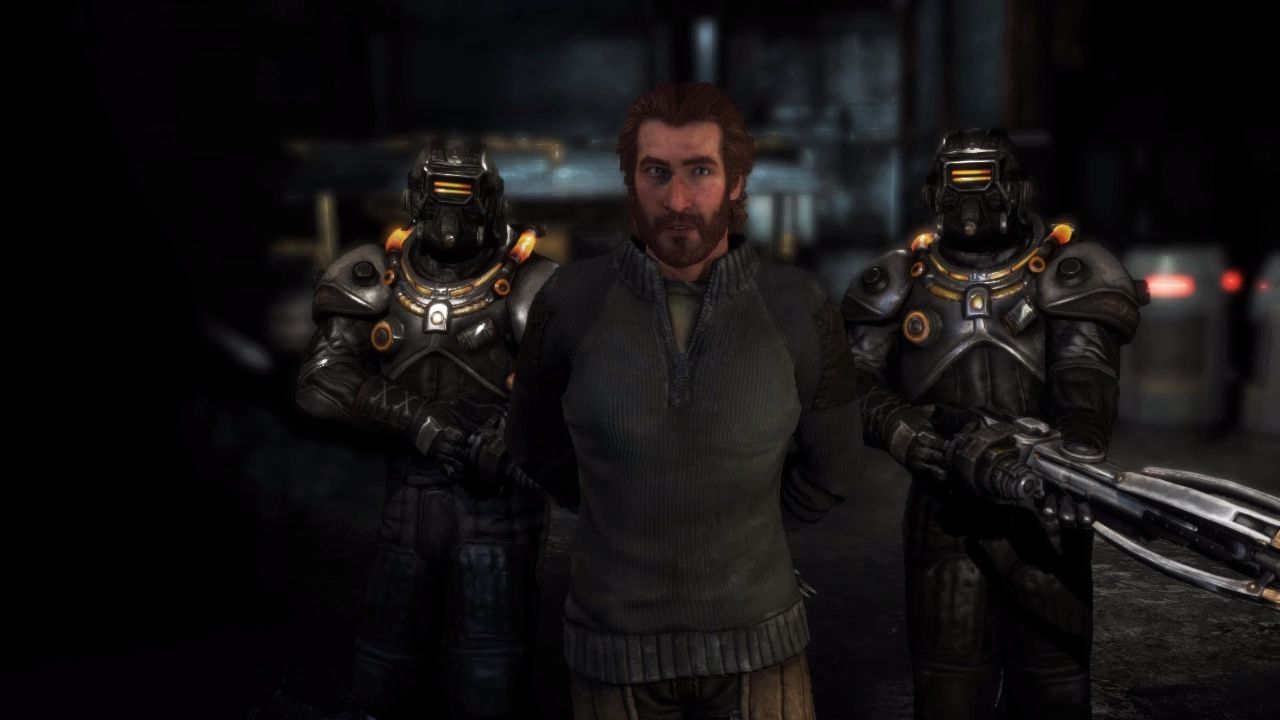
Ultimately, Lost Planet 3 is a collection of different inspirations that’s trying to appeal to a dozen different audiences all at once, but ultimately suffers from the same problem Resident Evil 6 had; it forgot to appeal to the audience that was already a fan of the series the game was a part of. The horror elements feel stale and tired, the adventure elements aren’t fleshed out enough to grab the attention of adventure fans, and there’s so little that resembles Lost Planet that it’s only a pale shadow of the other games. There are a few standout moments, the characterization is fresh, and could have carried a different genre of game all on it’s own. As a whole, Lost Planet 3 is a fragmented mess that might be fun when the price has come down to bargain bin prices, but anything more will feel like just as much of a rip-off as the rest of the game.
 (4 / 10)
(4 / 10)
Below Average
 (4 / 10)
(4 / 10)

